The Punch in the Face That a Poster Can Have
Curating Social Movements
Tuesday, August 19, 2014
ICI Curatorial Hub, Independent Curators International, New York
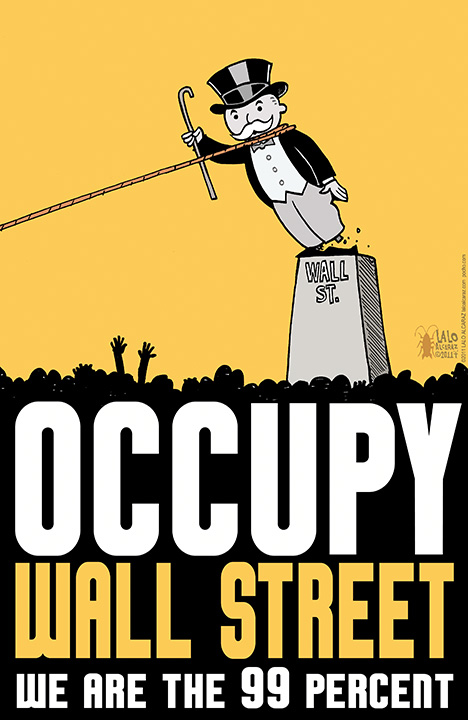
An Occupy Wall Street poster from 2011 by the artist Lalo Alcaraz
Weeks after the Occupy Movement started, in September 2011, museums began racing to collect the posters, flyers, and other materials from the protests. The Smithsonian Institution’s National Museum of American History dispatched archivists from Washington, DC, and the New-York Historical Society and the Museum of the City of New York sent representatives downtown, as reported by Artinfo, the Washington Times, and the New York Daily News. As an explanation, the Smithsonian released a statement on October 19 that read: “The Museum collects from contemporary events because many of these materials are ephemeral and if not collected immediately, are lost to the historical record.” In an editorial for CNN published in November, Michele Elam, a professor of English at Stanford University, wrote, “Occupy art might just be the movement’s most politically potent tool in its dramatic reframing of the racial dynamics of a populist uprising frequently characterized as largely white and ‘hippie.’” Academics, museums, and the media clearly recognized the importance of both Occupy and its visual culture in American history.
Though squatting in Zuccotti Park ended permanently by mid-November 2011, activists and artists kept the movement alive in myriad other ways. So did the institutions. In summer 2012, the Yerba Center for the Arts in San Francisco contextualized contemporary materials with those from the region’s storied past of political dissent in Occupy Bay Area. In spring 2013, the Davison Art Center at Wesleyan University in Middletown, Connecticut, organized Artists Take Action: Protest Posters Today, an exhibition of posters and ephemera from Occupy, some of which were borrowed from the Smithsonian. In that same year, the Museum of Modern Art added the Occuprint Portfolio, consisting of thirty-one screen prints (including work by Molly Crabapple, John Emerson, and Katherine Ball) from the Booklyn Artists Alliance, to its permanent collection.
At the beginning of “Curating Social Movements,” the curator Ryan Wong claimed that the topic of curating social movements is underdiscussed. “Social-movement stuff,” he said, “falls through the cracks.” Wong rightly identified curators as political actors—negotiation among parties of various backgrounds and competing interests is implicit in the job. He also correctly proposed that examining the visual culture of social movements help us to better understand their history. But considering the kinds of activity mentioned above, Wong’s notion that “art institutions are threatened by this kind of work, these objects,” felt off the mark. Which institutions are threatened, and what exactly is the threat?
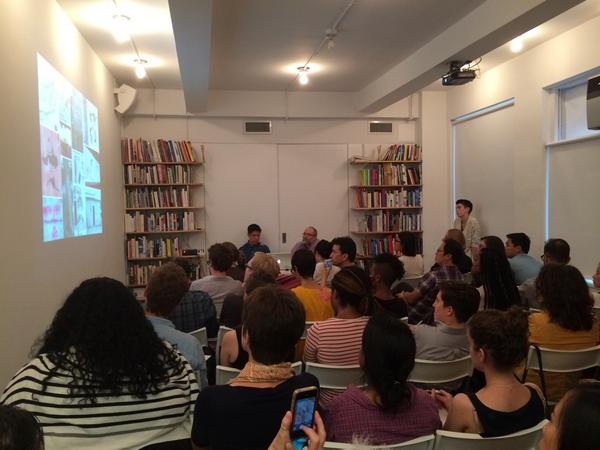
A view of “Curating Social Movements” at the ICI Curatorial Hub
Wong’s fellow panelist, the artist and activist Josh MacPhee, grew up as a punk-rock kid in Massachusetts, where he graduated from making flyers for bands to designing posters for housing struggles, bridging music and politics with cultural production. With Dara Greenwald, he organized Signs of Change: Social Movement Cultures 1960s to Now at Exit Art in 2008, an exhibition that served as a visual introduction to social movements around the world. (The show traveled to the Miller Gallery at Carnegie Mellon University a year later). MacPhee argued that the works of art, which were borrowed from eighty-two institutions, were integral to each movement’s political aspirations. Picking a bone with academia, he said that scholars tend to review what others have written (e.g., in journalistic accounts) and overlook the primary visual documents. I, too, find it odd that authors and historians could be so sloppy and wondered with scholars MacPhee had in mind.
MacPhee represented Interference Archive, a collectively run group that acquires and houses materials and objects from social movements from the 1960s to the present, stages exhibitions of them, and makes them available for study. Based in the Gowanus neighborhood of Brooklyn, the archive offers public programming, workshops, and events in a social space—just like many other libraries, museums, and cultural and educational centers. With a hands-on policy, he said, Interference Archive is not a quiet library.
MacPhee offered seven ideas to distinguish cultural production, which I understood as useful materials for a particular purpose, from political art, a genre that operates in the world of so-called fine art. The first notion was autonomy. If I understand him correctly, the visual culture of social movements does not have autonomy—background information beyond a caption is needed for comprehending the full message of an image. To demonstrate, MacPhee showed a 1963 photograph by Charles Moore, depicting four American civil-rights activists sprayed by water hoses. The underlying significance to the image, not readily apparent, is not that these people are protestors, but that they’re protestors who are organized. I liked this point of view very much, but overall MacPhee’s logic regarding autonomy was unclear, since context is hugely critical for untangling the meaning of much contemporary art.
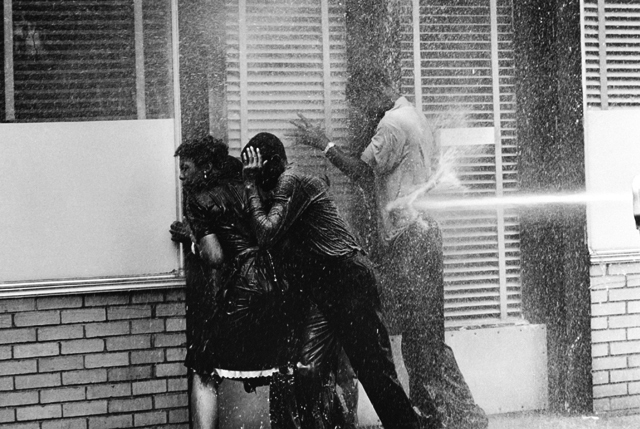
A Charles Moore photograph of the Children’s Crusade in Birmingham, Alabama, on May 3, 1963
The social forms of cultural production (MacPhee’s second idea) are important. He also emphasized the movement as producer (idea three), for which creative roles are flexible—teachers become television broadcasters. He also pointed out how arpilleras quilts were smuggled from Chile through the Catholic Church to raise funds for resistance efforts against a dictatorship. The stakes of visual material from social movements (idea four) are also vital: what are the intended goals apart from the individual concern? Prints depicting scenes from the Gwangju Uprising (by Hong Sung-dam and others) illustrated what was banned from television because, MacPhee said, journalists couldn’t work the right angle and the American government forced CBS not to broadcast footage. (Since I am not familiar with this history, I’ll take his word for it.) At this point MacPhee noted how Independent Curators International had recently been caught in crossfire with the BDS movement, which calls for boycotts, divestment, and sanctions against Israel, a country that, he noted, pays three to four times the regular fee for visiting speakers.1
Since upheaval generates cultural production, MacPhee identified cacophony as a fifth quality. In 1968 France, the Atelier Populaire generated thousands of revolutionary posters after protesters took over the equipment in the occupied École des Beaux Arts in Paris. He also mentioned a Nicaraguan artist “known for [his] Marlboro Man cowboy style,” whose images alluding to the wide-brimmed hat of the national hero Augusto César Sandino were adopted by the Sandinistas during the 1980s as a symbol of resistance. (Was Róger Pérez de la Rocha the name of this artist?)
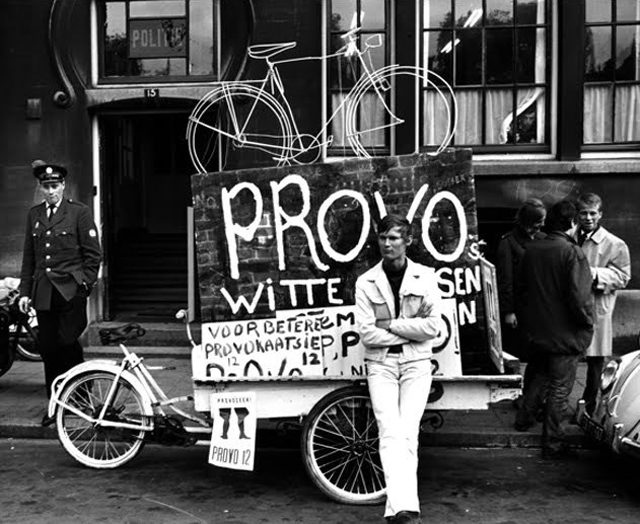
The White Bike Plan in Amsterdam was organized by a counterculture group called Provo
Marginal ideas transform the world, which MacPhee called prefiguration (his sixth notion), referring to prefigurative politics, for which people imagine a better society before trying to realize it. The mid-1960s White Bike Plan in Amsterdam would have given free access to bicycles in the Dutch capital, he told us, but the CitiBike idea for New York was seized by sinister venture capitalists, just like portions of the code on which Twitter was built came from the open-sourced TXTMOB in 2004. It would be interesting to read a comparative analysis between the reception of the White Bike Plan and CitiBike—perhaps something has already been written?
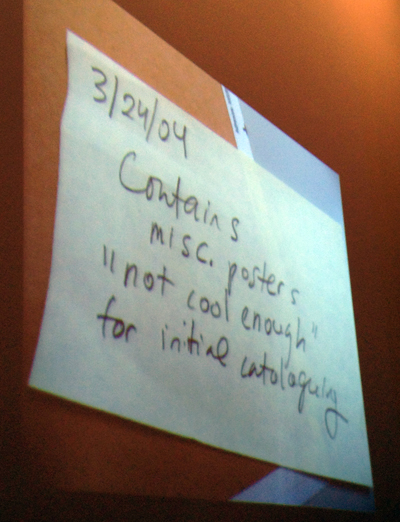
Cataloger’s note from the Museum of Modern Art Library (photograph by Christopher Howard)
MacPhee’s seventh and final idea argued that the art of social movements does not fit comfortably in museums and archives. Instead, he claimed, it often stays within the common—which probably means with private individuals who I imagine do not think of themselves as collectors or archivists. He showed a snapshot of a ten-year-old note referencing an unidentified collection of posters deemed “not cool enough” for initial cataloging by the Museum of Modern Art Library, which demonstrated a worker’s delightful sense of humor when prioritizing his or her work. Museums and institutions with different missions, though, happily collect social-movement ephemera, as I indicated in the opening paragraphs of this review. Nevertheless, I wonder if the creators of political posters aspire to have their work acquired by the Museum of Modern Art—or to any institution that desires to preserve and present them—or if such fetishization is antithetical to revolution.
Wong organized Serve the People: The Asian American Movement in New York at Interference Archive in 2013–14, presenting the work of numerous activists in the 1970s. Early on, Wong noticed that the movement did not have a Wikipedia page, and only a handful of academic books deal with the subject. “Google searches turn up little,” he said. His exhibition focused on the Basement Workshop in Chinatown, which he said was a place to talk, hang out, and make posters. Photographs from the era are banal but offer the energy of the moment, Wong said, which sounded like a contradiction to my ears. But no matter—this was the “first time,” he said, “where Asian Americans are controlling their own image.”
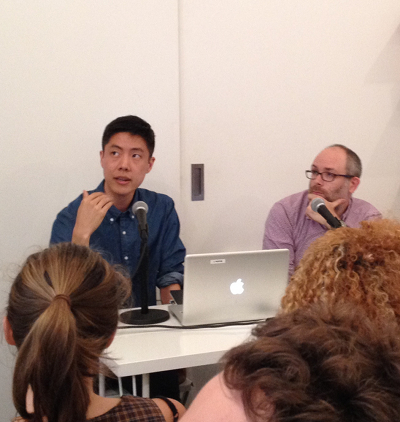
Ryan Wong talks about his exhibition Serve the People (photograph by Christopher Howard)
Serve the People incorporated diverse media: graphic works from the artist Tomie Arai; music from the folk record A Grain of Sand (1973) and by the jazz baritone saxophonist Fred Ho; copies of a newsletter called Getting Together; and posters for workshops, street fairs, and basic medical services; and more. The curator also included documentary photographs by Corky Lee of a Peter Yew protest against police brutality, during which twenty thousand people marched from Chinatown to City Hall. Wong said that didn’t know this kind of show was possible before [seeing] Signs of Change. When organizing Serve the People, Wong faced skeptics who asked him “Why now? Why you? What do you know about my history?” These are fair questions, but ones that a good curator will know how to answer.
Conversation during the audience Q&A covered measuring success, intergenerational communication, and exhibitions at Interference Archive, such as reconciling participant’s recollections against material evidence and maintaining community after a show ends. Though the two speakers didn’t offer a satisfactory answer to that last point—Wong even said that exhibitions “do violence” to the memories of the movement—it seems as if a good presentation should sufficiently inspire or agitate people to organize on their own (while including the institution, if they so choose). An exhibition space shouldn’t be relied on to be the only group that can effect social change.
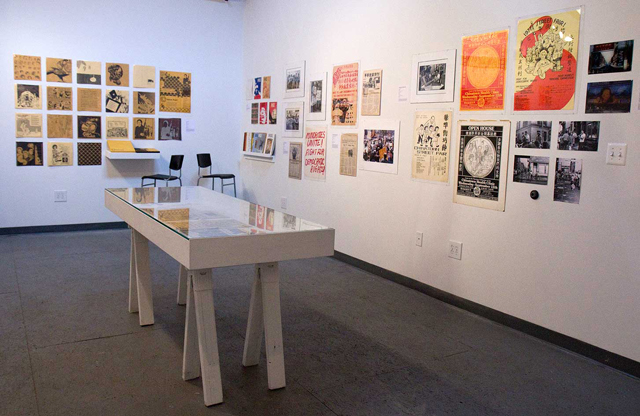
Installation view of Serve the People: The Asian American Movement in New York at Interference Archive
Interference Archive is staffed by volunteers, which come to the group out of desire. The organization minimizes hierarchy, MacPhee said, though he suggested that board members should be movement activists. He also said that 95 percent of funding comes from visitors via memberships, passing the jar at events, and selling works, which makes organizational sustainability an issue, especially regarding digital issues in archival work.
Digitization isn’t a solution to accessibility, MacPhee explained, noting the time, money, and labor that goes into the effort—not to mention the difficulties of conducting additional research, assessing impact, and giving materials proper frames of reference in the face of the internet’s decontextualizing force. It’s better to set up archives in other communities, he recommended, and Wong noted that cultural production for the Asian American Movement is spread across the country: Los Angeles, San Francisco, Seattle, and New York. Each city can build its own Interference Archive. Someone suggested forcing big museums to do this work, but anyone who has spent time in a nonprofit knows that even the most prominent institutions suffer from an overburdened workforce. There is hope: Interference Archive has a Born Digital Working Group assessing the situation of storing and facilitating the migration of electronic material for future accessibility. But alas, “There’s no funding stream for an archive,” MacPhee resigned.
An audience member asked about discernment when collecting objects, especially with movements whose political beliefs (such as white power or the Tea Party) may not align with the left-oriented Interference Archive. MacPhee said his group collects material from all kinds of movements and has accumulated right-wing stuff from what he called “counterintelligence” collections, not from the movements themselves. He explained that right-wing activists have typically favored television talk shows over printed matter—remember all those skinheads on Donahue and Geraldo? MacPhee clarified that even people on the left espouse violence, homophobia, and a naïve understanding of revolution.
“Are kids still doing this?” someone asked regarding cultural production for social movements. “Yes, all over the place,” MacPhee responded positively. That was good to hear.
In Terms Of count: 6½.
1 See Mostafa Heddaya, “Creative Time Reneges on Promise to BDS Artists with Israel Exhibition, Artist Withdraws,” Hyperallergic, June 5, 2014; and Anne Pasternak and Nato Thompson, “Creative Time Responds to BDS Arts Coalition Petition” Creative Time, June 13, 2014.


